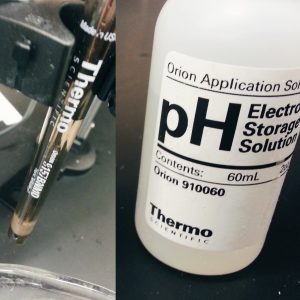A Winemaker’s Journey to Understanding Acid Chemistry
One of the most common mistakes I hear winemakers make is when they reference a wine’s pH in response to someone else’s comment on how sour the wine tastes. We’ve all heard it.
Someone: “The wine is a bit tart.”
Winemaker: “Well, the pH is 3.24.”
This simple misuse of an analytical value automatically makes us all assume the wine is sour because of the pH value. To some degree, it’s true: anything under a pH of 7.00 is considered an acidic mixture. Wine, on average, falls within a 2.80 to 4.20 pH range: and all of those values are indeed acidic values.
But can we, as humans, tell the difference in a wine’s taste between pH of 3.20 and 3.24? Or 3.24 and 3.50? I would have to argue “maybe, but not clearly.”
The clearer analytical reference in response to someone commenting a wine is sour/tart/crisp is to provide them with the titratable acidity or TA. Because, as humans, we can actually taste the difference in a wine that has a TA of 4.0 g/L tartaric acid versus a wine that has a 6.0 g/L tartaric acid value. And here’s the kicker: both wines could have the same or similar pH values. It’s possible.
This may seem nitpicky. However, there’s real value in responding with the correct analytical measure. Furthermore, pH has a very important role in wine and it is something winemakers should know about their wines. Let’s further explore the importance of pH in wine.
What is an Acid?
An acid, by definition, is “any molecule that will ionize (or, separate) into a proton (typically abbreviated as “+”) and an anion (typically abbreviated as “-“).”
This definition is important, because pH is a measure of the free hydrogen protons (often abbreviated “H+” in a solution (which is scientific jargon for a liquid mixture). The term “free” is important in this definition as the protons have no association with any one molecule in the mixture. They are essentially floating around and readily available to react with other substances in the mixture.
Wine is in itself a mixture, composed of lots of different chemical constituents including several organic acids. Ninety-five percent (95%) of acid content in wine is related to six acids: tartaric, malic, lactic, acetic, citric, and succinic (Waterhouse, Sacks, and Jeffery, 2016). Tartaric and malic acid both come from the grapes themselves, extracted from the berry and retained during the fermentation process. Acetic, citric, and succinic are developed by the yeast during primary fermentation, though acetic acid can also come from other microflora native to the grape or through contamination in the cellar. Lactic acid is developed by a conversion of malic acid to lactic acid, which is thoroughly discussed in “The Dot Races” webinar. While this conversion can occur during primary fermentation, it is usually more heavily isolated to the malolactic fermentation, or second fermentation, process.
Why is Acid Chemistry Important to the Winemaking Process?
The inclusion and ratio of organic acids in wine contribute to wine’s chemical properties and overall existence.
For example, acetic acid is a primary acid in wine, though its concentration has to be under a specific value in order for the mixture to still be considered “wine.” Higher concentrations of acetic acid typically signify spoilage of the wine, lending its way to vinegar instead of wine.
Furthermore, the concentration and ratio of tartaric and malic acid dictate the wine’s buffering capacity. Buffering capacity is a measurement that describes how well a buffer resists changes in pH. Because wine has great buffering capacity, making acidification or deacidification additions are not straightforward. The buffering capacity, however, protects the wine from falling out of the acid range on the pH scale. This is why winemakers rarely have to worry about things like food borne pathogen risks: the pH falls below 4.60 and it’s really difficult to get the wine close to that value.
Nonetheless, pH dictates many different properties related to wine:
- Color: Both color extraction and stabilization are related to the pH of the wine. If a wine’s pH falls outside of optimal for either process, it’s possible the process will not be efficient or complete normally.
- Microbial Stability: The natural pH range of wine narrows the possibility of microorganisms that can survive in or on wine. Wines that lean on the higher pH side (closer to 4.0) tend to have less protection against the microorganisms that can inhabit wine. Hence, winemakers need to take extra care in monitoring their wines to ensure quality.
- Chemical Stability: pH influences many different chemical constituents of wine. It plays a role in color stability, cold stabilization, protein stability, tannin reactions, sulfur dioxide stability, potassium sorbate stability, and many chemical reactions. Awareness of how pH can affect these various constituents can help winemakers make wiser production choices for a given wine.
Get More Comfortable with pH

While we talk about pH all of the time, many winemakers rarely feel comfortable discussing its influence on their wines and measuring it. For this reason, on April 23rd, the Darn Good Winemakers session will focus on all things pH in the webinar: pH Explained – The Importance of pH in Wine.
- Understanding it scientifically
- Applying pH to various winemaking practices
- And using good pH meter practices to monitor pH through production.
pH Explained is scheduled for April 23, 2019 at 4:00 PM (EST). Like all Darn Good Winemakers sessions, the webinar will be recorded and available to watch for all registered Darn Good Winemakers and DGW clients.
Want to join us? You can join the Darn Good Winemakers network at any time! Your membership is active for 12 consecutive months. Plus, you can view all past Darn Good Winemakers webinars currently posted on the DG Winemaking website. For more information on the Darn Good Winemakers, check out my intro video, here.
References
Waterhouse, A.L., G.L. Sacks, and D.W. Jeffery. (2016). Understanding Wine Chemistry. ISBN: 978-1-118-62780-8
